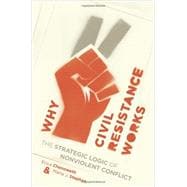
Note: Supplemental materials are not guaranteed with Rental or Used book purchases.
Purchase Benefits
What is included with this book?
| List of Illustrations | p. ix |
| List of Tables | p. xi |
| Acknowledgements | p. xiii |
| Why Civil Resistance Works | p. 1 |
| The Success of Nonviolent Resistance Campaigns | p. 3 |
| The Primacy of Participation in Nonviolent Resistance | p. 30 |
| Exploring Alternative Explanations for the Success of Civil Resistance | p. 62 |
| Case Studies | p. 85 |
| Introduction to the Case Studies | p. 87 |
| The Iranian Revolution, 1977-197? | p. 92 |
| The First Palestinian Intifada, 1987-1992 | p. 119 |
| The Philippine People Power Movement, 1983-1986 | p. 147 |
| Why Civil Resistance Sometimes Fails: The Burmese Uprising, 1988-1990 | p. 172 |
| Case Study: Summary | p. 192 |
| The Implications of Civil Resistance | p. 199 |
| After the Campaign: The Consequences of Violent and Nonviolent Resistance | p. 201 |
| Conclusion | p. 220 |
| Epilogue | p. 229 |
| Appendix | p. 233 |
| Notes | p. 243 |
| References | p. 261 |
| Index | p. 279 |
| Table of Contents provided by Ingram. All Rights Reserved. |
The New copy of this book will include any supplemental materials advertised. Please check the title of the book to determine if it should include any access cards, study guides, lab manuals, CDs, etc.
The Used, Rental and eBook copies of this book are not guaranteed to include any supplemental materials. Typically, only the book itself is included. This is true even if the title states it includes any access cards, study guides, lab manuals, CDs, etc.